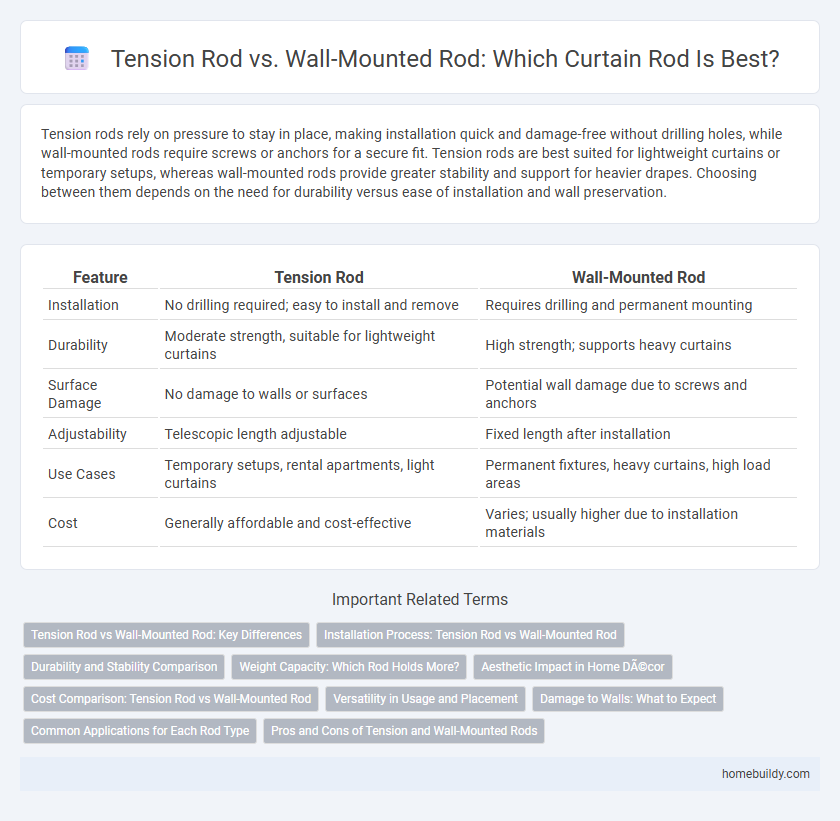Tension rods rely on pressure to stay in place, making installation quick and damage-free without drilling holes, while wall-mounted rods require screws or anchors for a secure fit. Tension rods are best suited for lightweight curtains or temporary setups, whereas wall-mounted rods provide greater stability and support for heavier drapes. Choosing between them depends on the need for durability versus ease of installation and wall preservation.
Table of Comparison
| Feature | Tension Rod | Wall-Mounted Rod |
|---|---|---|
| Installation | No drilling required; easy to install and remove | Requires drilling and permanent mounting |
| Durability | Moderate strength, suitable for lightweight curtains | High strength; supports heavy curtains |
| Surface Damage | No damage to walls or surfaces | Potential wall damage due to screws and anchors |
| Adjustability | Telescopic length adjustable | Fixed length after installation |
| Use Cases | Temporary setups, rental apartments, light curtains | Permanent fixtures, heavy curtains, high load areas |
| Cost | Generally affordable and cost-effective | Varies; usually higher due to installation materials |
Tension Rod vs Wall-Mounted Rod: Key Differences
Tension rods rely on adjustable pressure between two surfaces for installation, eliminating the need for drilling or permanent fixtures, making them ideal for renters or temporary setups. Wall-mounted rods require screws and anchors for secure placement, offering greater stability and weight capacity for heavier curtains or longer-term use. While tension rods provide quick, damage-free installation, wall-mounted rods deliver enhanced durability and support for a broader range of applications.
Installation Process: Tension Rod vs Wall-Mounted Rod
Tension rods require no drilling or hardware, relying on adjustable pressure to fit securely between two surfaces, making installation quick and damage-free. Wall-mounted rods necessitate precise measuring, drilling holes, and securing brackets with screws, resulting in a more permanent and stable fixture. The ease of installation with tension rods suits renters or temporary setups, while wall-mounted rods offer greater durability for long-term use.
Durability and Stability Comparison
Tension rods rely on spring pressure to stay in place, making them less stable and potentially less durable under heavy loads or over time. Wall-mounted rods are secured with brackets drilled into the wall, offering superior stability and long-term durability. For support of heavy curtains or frequent use, wall-mounted rods provide a more reliable and robust solution.
Weight Capacity: Which Rod Holds More?
Tension rods rely on internal spring pressure to stay in place, typically supporting lighter loads up to 30 pounds, making them ideal for curtains or lightweight items. Wall-mounted rods are anchored directly into studs or wall brackets, offering significantly higher weight capacity--often exceeding 100 pounds--making them suitable for heavy drapes or industrial uses. Choosing between tension rods and wall-mounted rods depends largely on the required weight support, with wall-mounted rods providing superior durability and load-bearing strength.
Aesthetic Impact in Home Décor
Tension rods offer a sleek and minimalistic look without the need for drilling, preserving wall integrity for a cleaner aesthetic in home decor. Wall-mounted rods provide a sturdy, permanent fixture that can support heavier curtains and be customized with decorative brackets for enhanced visual appeal. Choosing between tension and wall-mounted rods depends on the desired balance between ease of installation and the overall design impact in a space.
Cost Comparison: Tension Rod vs Wall-Mounted Rod
Tension rods typically cost less than wall-mounted rods due to their simple installation requiring no drilling or hardware. Wall-mounted rods involve higher expenses from mounting brackets, screws, and potential wall repairs, making them pricier overall. Budget-conscious consumers often prefer tension rods for their affordability and ease of setup in temporary or rental spaces.
Versatility in Usage and Placement
Tension rods offer exceptional versatility in usage and placement due to their no-drill installation method, allowing easy repositioning without damaging walls. Wall-mounted rods require permanent installation with hardware, limiting flexibility but providing increased stability for heavier curtains or fixtures. Tension rods excel in temporary setups or rental spaces, while wall-mounted rods suit long-term, heavy-duty applications.
Damage to Walls: What to Expect
Tension rods minimize damage to walls by relying on adjustable pressure rather than screws or nails, making them ideal for rental properties or delicate surfaces. Wall-mounted rods require drilling holes, which can leave permanent marks and weaken wall integrity over time. Choosing tension rods reduces the risk of wall damage and simplifies installation and removal processes.
Common Applications for Each Rod Type
Tension rods are commonly used for lightweight curtains in rental spaces or areas where drilling is not permitted, providing easy installation and removal without wall damage. Wall-mounted rods are suited for heavier draperies and long-term installations, offering greater stability and support for substantial curtain fabrics. Both rod types cater to different functional needs, with tension rods favored for temporary or adjustable setups and wall-mounted rods preferred for permanent decor solutions.
Pros and Cons of Tension and Wall-Mounted Rods
Tension rods offer easy installation without drilling, making them ideal for renters or temporary setups, but they may lack the stability and weight capacity of wall-mounted rods. Wall-mounted rods provide superior strength and durability for heavy curtains or long-term use, though installation requires tools and leaves permanent marks on the wall. Choosing between tension and wall-mounted rods depends on the balance between ease of use and structural support needed for your space.
Tension rod vs Wall-mounted rod Infographic

 homebuildy.com
homebuildy.com